Knottallow Tarn: Fishing Methods
Knottallow Tarn: Fishing Places
There is no "best" place to fish in Knottallow Tarn! Knottallow Tarn does not have any hotspots, it is up to the fly
fisherman to observe the water and see where the fish are taking flies.
Knottallow Tarn: Match the Hatch
Knottallow Tarn is similar to other natural waters where the stocked Brown Trout rapidly become naturalized
and start to feed on terrestrial insects. Anglers can fish lures but should be aware that its the anglers who
fish imitative techniques and "match the hatch" are more successful and record catches often in to double figures.
The fishery has an abundance of natural fly life and will appeal to anglers who adopt an imitative approach. At the start of the
season small Buzzer imitations should be your first choice with maybe a Black Spider on the top dropper. On colder days when fish
are reluctant to respond, a mini lure in black or olive can be deadly. As the water warms up Buzzers in all their various forms can
be tried with a small black shipmans being a favourite on calm days. Larger dries such as foam beetles, hoppers and sedges can also
be successful on their day and try a small caenis imitation if there is a hatch in the evenings.
It really is a case of seeing what's on the water and trying to "Match the Hatch".
Knottallow Tarn: Fly Life
Chironomids are present throughout the year, but particularly in early and late season. Shrimp and Corixa are also evident
all year round. Mid-summer will see good Caenis hatches in the evenings, and the appearance of the sedges, mainly longhorns and
grouse-wings. There is also a good head of damselflies. Being surrounded by agricultural land, the fishery also benefits from
regular appearances of terrestials such as black gnats, beetles and crane flies.
Below are a series of flies suggested by the regulars who fish Knottallow Tarn. If you would like to see some more suggestions
of flies to use on Knottallow Tarn then check out Paul Procter's suggested flies to
fish on Knotallow Tarn by following the link.
Knottallow Tarn: Insect Emergence Calendar
If you would like to some more information on when to fish certain fly patterns on Knottallow Tarn then check out
Knotallow Tarn Insect Emergence Calendar by following the link.
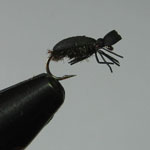
|
Ethafoam Beetle
In waters as high up as Knottallow Tarn, terrestrial beetles provide a significant food
source for trout in the summmer and autumn. There are many types of beetles from the Bracken
Clock through to the ladybird. These can all be represented in some form by the ubiquitous
ethafoam beetle. This beetle should be fished on the surface. Use these beetles in hook sizes of
12 through to 16. Dropping an ethafoam beetle in front of cruising fish can sometimes induce a take.
Small beetles (hook size 16 - 20) which are caught in the surface film may be mistaken for
small corixa and this method has proven successful on Knottallow Tarn. A good alternative is a Coch-y-bondhu.
|
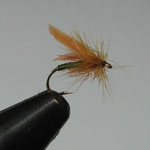
|
Cow Dung Fly
The cow dung fly lays eggs in cow, horse and sheep dung and appear around May through to late
summer. This is a old traditional pattern and should be fished on windy days when the wind pushes
these insects onto the water. You can also use these flies on windless days if there are no hatches
coming off the water as you may be offering an irresistible treat.
|
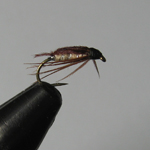
|
Corixa
During the entomology days on Knottallow Tarn the most abundant creature in the water is the Corixa - a small beetle-like creature
forever rising to the top to gather an air bubble then return back to the bottom. The air bubble on the underside of the Corixa's
abdomen looks like a bead of mercury held between its legs. They are an important food source for the trout
in Knottallow and must not be ignored the fly fisherman. Fish the Corixa just below the surface.
Thanks to Dave Helm for providing his pattern for the photo.
|
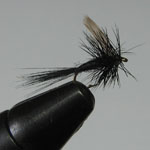
|
Black Gnat
Anglers use the black gnat pattern to represent several terrestrial species of flies that live near water and provide
a food source for trout. The black gnats usually habit the margins and can be seen in swarms.
If you don't have a Black Gnat in your box then any dark fly around size 16-18 will do, or use a Griffiths Gnat.
|
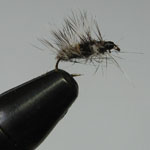
|
Griffiths Gnat
A good all round pattern. This dry fly is used to represent a simple imitation of a small black
midge (or several other small flies). The fly floats half in and half out of the surface film
representing something stuck, trying to emerge from its shuck.
|

|
Hopper
A Hopper represents natural creatures such as the crane fly and is seen by the trout as some kind of
natural insect on the water. It can be fished in the surface film, just below or as a dry on the top and
is a versitile fly whichever way you choose to fish it. Many Daddy Longlegs or Crane Flies appear on Knottallow
Tarn from June to early October. This fly makes a decent mouthful and will often tempt when other pattern may be
ignored. BE PREPARED - Sometimes the hopper is snatched as soon as it lands on the water!
|
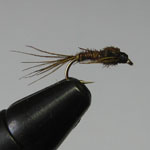
|
Pheasant Tail Nymph
A classic fly which makes a superb representation of many nymphs. This can be the fly to fish when you don't know
which fly to choose because there is nothing hatching or falling onto the water. This fly can be fished to mimic a
nymph picking on food on the bottom or as an imitation of a nymph rising to the surface prior to emerging.
|